2018 Infiniti QX80 4WD
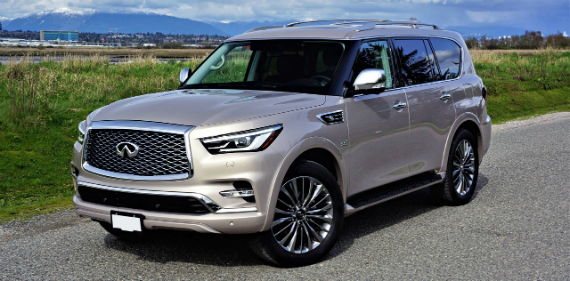
I’ve got a challenge for you. Take a 2018 Infiniti QX80 for a drive and then tell me why it’s not worth $20k more than the $64,750 they’re asking. My guess? You’ll soon be comparing it to full-size SUV rivals from Land Rover, Lexus, and even Mercedes-Benz.
To put its price into perspective, I sized up competitive MSRPs from its closest challengers and found out you can get into a well-equipped, impressively finished base model of the handsomely refreshed 2018 Infiniti QX80 for $22,175 less than the 2018 Lexus LX 570, $22,600 less than the Land Rover Range Rover, and $58,850 less than the base Mercedes-Benz G 550. What’s more, the QX80 is $7,805 more affordable than the new 2018 Lincoln Navigator and costs $9,945 less than the 2018 Cadillac Escalade, which should have all of us questioning whether Infiniti priced its full-size SUV too low.
To the ridiculously wealthy such pricing discrepancies won’t make one bit of difference, but value matters to smart luxury SUV shoppers trying to maximize the most from their hard-earned income. To that end the QX80 won’t disappoint, starting with a thorough mid-cycle update for 2018 that includes a redesigned grille, front fascia, hood, fenders, fender vents, and rear bumper, while its LED headlamps, LED taillights, LED fog lamps, and side indicators have been dramatically revised as well. Lastly, Infiniti rounded out the updated exterior design with new 20- and 22-inch alloy wheels, while new exterior colors include Moonstone White, Mineral Black and my tester’s Champagne Quartz, which works really well with all the new details.
Climbing inside reveals some updates to the cabin as well, including a standard contrast-stitched wrapped upper instrument panel and a new shift knob, plus a new stitched and leather-wrapped steering wheel hub/horn pad and diamond-patterned quilting for the upgraded semi-aniline leather door trim and seat inserts, the choice of which required adding the $5,700 Deluxe Technology Package. The result is a cabin that looks and feels really rich, matched by high-quality materials like premium soft-touch synthetics on key surfaces including the entire door panels from top to bottom (not so with some competitors), good attention to detail, tight fitment of panels and switchgear, some of the latter finished in beautiful knurled metal, and an overall sense of solidity.
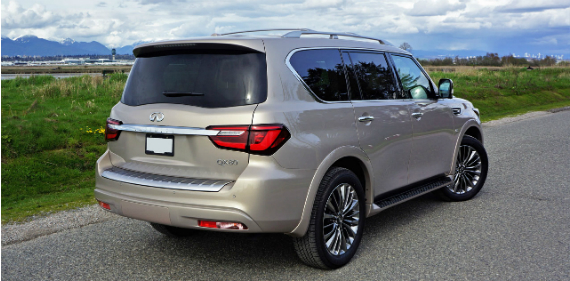
The Deluxe Technology Package also includes beautiful high-gloss Espresso Burl hardwood trim around the steering wheel, across the dash and door panels, and down the center stack and lower console, plus an Infiniti-first Smart Rear View Mirror that doubles as a wide-angle rearview camera, a superb sounding Bose Cabin Surround audio system with digital 5.1 decoding, Bose Centerpoint 2 signal processing, 15 speakers and more, an Advanced Climate Control System (ACCS) with auto recirculation, a Plasmacluster air purifier and a Grape Polyphenol Filter, climate-controlled front seats, second-row footwell courtesy lights, and front seat pre-crash seatbelts on the inside, while the exterior gets an Adaptive Front lighting System (AFS) with auto-leveling headlights and headlight washers, chrome mirror caps, Hydraulic Body Motion Control to further enhance handling, and more.
Opting for the Deluxe Technology Package means that you’ll also be required to upgrade to a $2,900 Driver Assistance Package that features Intelligent Cruise Control with Full-Speed Range, Predictive Forward Collision Warning (PFCW), Forward Emergency Braking with Pedestrian Detection, Distance Control Assist, Blind Spot Warning (BSW), Blind Spot Intervention (BSI), Lane Departure Warning (LDW), Lane Departure Prevention (LDP), Backup Collision Intervention (BCI), and a steering wheel switch for the Safety Shield Technologies; plus a $2,450 Theater Package that adds a rear entertainment system with dual 8.0-inch displays, two pairs of wireless headphones, a remote control, aux inputs, heated second-row outboard seats, remote tip-up second-row seats, and more; and $2,800 22-inch Tire and Wheel Package mentioned earlier, which are gorgeous 18-spoke forged aluminum alloys shod with 275/50R22 H-rated all-season performance tires; which together with $3,100 for 4WD upped my tester’s price to $83,495 plus freight and fees.
Added to this was another $450 for 4G WiFi that allows up to five WiFi-enabled devices to securely connect to the internet, while Infiniti chose not to include the $250 Split Bench Seat Package that replaces the rear captain’s chairs with a 60/40-split bench and increases passenger volume from seven to eight.
Additionally, a new no-cost optional interior color treatment includes Saddle Brown with Charcoal Burl Trim, plus the QX80’s Wheat motif has been updated from low contrast to high contrast. Likewise, the Graphite gray interior gets updates too.
No-cost in mind, an 8.0-inch InTouch Single Display infotainment touchscreen comes standard, as does an Around View Monitor (AVM) with Moving Object Detection (MOD), Infiniti InTouch Navigation, Infiniti InTouch Services, Infiniti Connection telematics, voice recognition, NavTraffic with real-time traffic info, satellite radio, streaming Bluetooth audio, multiple USB charging ports, and more.
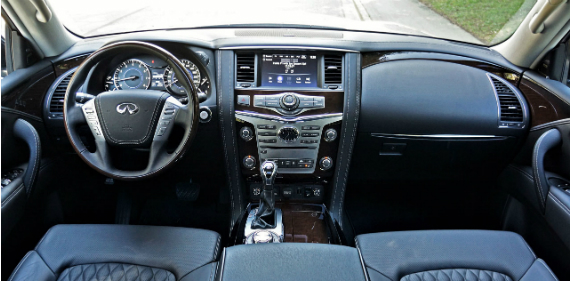
Additional standard features include underbody skid plates to protect vulnerable components while off-roading, body-color running boards, roof rails, remote engine start, proximity access with pushbutton ignition, aluminum kick plates, power-folding, auto-dimming, heatable side mirrors with integrated turn signals, courtesy lamps and reverse tilt down, a heated leather-wrapped multi-function steering wheel, a powered steering column, auto on/off LED headlights with auto high beam assist, rain-sensing wipers, an auto-dimming center mirror, a classy analog clock, a HomeLink garage door opener, easy to use tri-zone automatic climate control, always appreciated front and rear parking sensors, a powered moonroof, handy two-way memory for the driver’s seat, side mirrors and steering column, a very comfortable 10-way powered driver’s seat with two-way powered lumbar support, and an eight-way powered front passenger’s seat with powered lumbar support.
Those standard seats are covered in leather upholstery, albeit not quite as soft and supple as the semi-aniline hides found in my tester, plus they’re heated for cold-weather comfort up front, while my tester’s standard second-row captain’s chairs also came heated, and feature a tip-up easy entry system for the third row that’s simple to operate, plus the 60/40-split third row seats are power-folding and reclining.
A powered rear liftgate is included too, as is a stainless steel rear bumper protector, an integrated Class IV tow hitch with a covered seven-pin wiring harness, tire pressure monitoring, Hill Start Assist, Trailer Sway Control, all expected active and passive safety systems, plus more.
My only complaints include a gauge cluster and an infotainment display that are a bit behind the curve. Okay I’m being generous, as the primary instruments clearly don’t measure up to the expected full color, TFT, digital wonderment provided by most rivals. By so saying I’m not pronouncing it unfit for business. Its electroluminescent dials are actually quite lovely, while their bright background lighting can be seen in most any lighting condition. The monochromatic trip computer at center, however, might be the oldest of its type in existence, especially when compared to the high-resolution color TFT display in your average Honda Civic, but such issues will be taken care of in due time as seen in some of Infiniti’s more recently redesigned models. You just need to be made aware of them now, as throwback electronics can make any new vehicle seem pretty old.
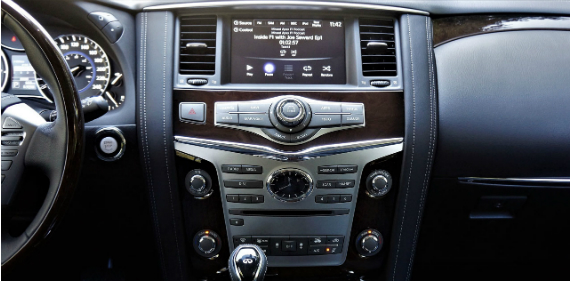
In contrast the infotainment display is much better, and while not top of its class it certainly works well. The touchscreen isn’t all shiny and high-contrast as is en vogue these days, but its matte finish is nevertheless fairly high in resolution and it’s replete with a bevy of useful functions, with a split-screen of backup and overhead surround cameras, bright, clear and accurate navigation mapping, climate and audio controls, which again can be monitored by a split screen for multitasking, rear entertainment controls, driving info like an Eco Drive Report, a nice graph showing average fuel economy (at 14 mpg, ugh! — the actual EPA numbers are 13 city, 19 highway and 15 combined with 4WD), one for individual tire pressure, a Performance Meter, and so on, while the various menus are filled with nice big digital buttons, some colorful and others a medium blue. I’m not a fan of Android Auto so couldn’t care less that it’s not included, but iPhone owners might wish for Apple CarPlay, which is a much better interface.
As for roominess, few people will actually need this much space. Front headroom is NBA-level tall, while you should have ample side-to-side movement as well. The driver’s seat was superbly comfortable and fully adjustable too, which when combined with the powered steering column made for an ideal fit, aiding comfort and control.
Likewise, the rear quarters are ultimately roomy and extremely well finished. Rear passengers will appreciate roof vents that extend right back to the third row, while there’s also a separate climate control interface on the backside of the front console with heated seat buttons for the second row, plus other plug-ins for the rear entertainment system, the monitors of which get mounted to the backside to the front headrests.
This seven-passenger model features a large center console between the two second-row captain’s chairs, with its top finished in a nice hardwood veneer, this just ahead of a leather armrest covering a deep storage bin below. You can also access a secondary storage bin from a front hatch, plus two small cupholders are kept hidden below a nice wooden lid up top as well. This said the construction of the console’s base feels kind of cheap, in that it’s basically formed from a massive hard plastic shell that I found a bit disappointing for this class and price range.

On the positive, the third row is easy to access thanks to second-row seats that pop up and out of the way automatically, providing a wide walkthrough. The rearmost seats are large enough for adults too, even three across, while Infiniti provides multiple side cupholders next to rocker switches for reclining the rear seatbacks.
The cargo area is fairly large at 16.6 cubic feet behind the third-row, and comes complete with a lidded floor providing some hidden storage below. The third row seats power down, albeit ever so slowly, providing up to 49.6 cubic feet of available cargo space, and then power back up again. You need to walk around to the side doors to lay the second-row seats flat, but when you do the QX80 provides a massive 95.1 cubic feet of load area, but with a sloped floor at center. Also, that second-row center console gets in the way if you have plans of hauling 4x8 sheets of building material, as it protrudes upward in the middle, so if you’re a do-it-yourselfer I’d recommend going for the eight-seater that fits a regular bench seat into the second row.
Speaking of hauling, the QX80’s standard 5.6-liter V8, good for 400 horsepower and 413 lb-ft of torque and mated to a quick-shifting seven-speed automatic transmission that powers all four wheels via Infiniti All-Mode 4WD with Snow and Tow Modes, can manage up to 8,500 lbs, which is a sizable trailer whether suited up for camping or boating.
Unfortunately I didn’t have time for either, but enjoyed the QX80’s power off the line, when passing on the open highway, and likewise appreciated the big SUV’s surprising agility through fast-paced, tight corners. It really feels like a much smaller utility when pushed hard, yet all the while it provides a truly comfortable ride thanks to plenty of suspension travel and good overall compliance.
If off-roading is your thing, take note the QX80 has at least as much 4x4 heritage as its aforementioned rivals, thanks to sharing underpinnings with Nissan’s Armada, which in turn is a rebadged Nissan Patrol, a rugged, go-anywhere SUV nameplate that’s become legendary throughout the world since it arrived on the scene in 1951. That means it’s as experienced and well respected in global off-road circles as Land Rover’s Defender, Toyota’s Land Cruiser and others, the latter forming the basis for the Lexus LX, while Mercedes’ impressive G-Class, or Gelandewagen, only dates back to 1979.
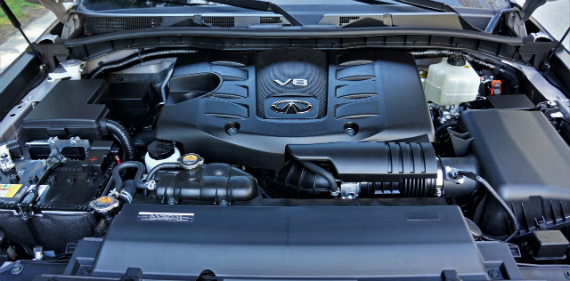
All have decades-long ties to militaries worldwide, not to mention relief organizations, policing, businesses requiring wilderness travel, etcetera, and that on- and off-road prowess can immediately be felt by driver and passengers. The QX80 is a solid, well-built vehicle first and foremost, and an impressively finished luxury SUV after that, which is all the more reason to be amazed at its highly competitive pricing.
In summary, the 2018 Infiniti QX80 brings a stylish new design, numerous interior refinements, continued strong performance, and particularly good value to the full-size SUV market. I recommend you take up the challenge and enjoy some quality time behind the wheel.
Story credits: Trevor Hofmann, American Auto Press Photo credits: Karen Tuggay, American Auto Press Copyright: American Auto Press
